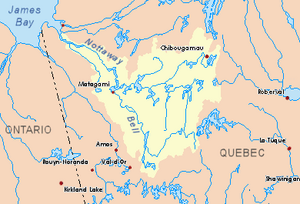Allard River facts for kids
Quick facts for kids Allard |
|
|---|---|

Watershed of Nottaway River
|
|
| Country | Canada |
| Province | Quebec |
| Region | Eeyou Istchee Baie-James (municipality) |
| Physical characteristics | |
| Main source | Unidentified Lake Eeyou Istchee Baie-James (municipality), Nord-du-Québec, Quebec 283 m (928 ft) 49°18′02″N 77°59′19″W / 49.30056°N 77.98861°W |
| River mouth | Lake Matagami Eeyou Istchee Baie-James (municipality), Nord-du-Québec, Quebec 253 m (830 ft) 49°49′58″N 77°45′01″W / 49.83278°N 77.75028°W |
| Length | 63.5 km (39.5 mi) |
| Basin features | |
| Tributaries |
|
The Allard River is a river in Quebec, Canada. It flows into the western side of Lake Matagami. This lake then empties into the Nottaway River. The Allard River is located in the Eeyou Istchee Baie-James municipality in the Nord-du-Québec region.
A road called Route 109 runs north along the western side of the upper Allard River. This road eventually leads to the town of Matagami. Another road, R1027, crosses the Allard River about 10 kilometers (6 miles) south of where it meets Lake Matagami. This road continues north towards the areas east of James Bay.
The Allard River flows through forests and marshy (swampy) areas. It is located southwest of Lake Matagami. The river's surface is usually frozen from early December until the end of April.
Contents
Where is the Allard River?
The Allard River is surrounded by other important water bodies. These are called its "hydrographic slopes." Think of them as the areas that drain water into or near the Allard River.
- North: Bouchier Lake, Kitchigama River
- East: Lake Matagami, Daniel River, Bell River, Dollard Creek
- South: Harricana River, Daniel River, Indian River (Bell River)
- West: Grasset Lake, Bear River, Harricana River, McClure Creek, Adam River
The Allard River starts from a small lake. This lake is on the northwestern side of the area that separates the Allard River's water from the Indian River (Bell River).
The Source of the River
The Allard River begins in a small lake. This lake is about 0.6 kilometers (0.4 miles) long and sits 283 meters (928 feet) above sea level. It is located in the Eeyou Istchee Baie-James municipality. This starting point is just north of the border with the Abitibi-Temiscamingue region. The lake is where four different land sections (called townships) meet: Sauvé, Razilly, Soissons, and Maizerets.
From its source, the Allard River flows for about 63.5 kilometers (39.5 miles). Its journey can be divided into two main parts:
Upper Part of the Allard River
This section is about 37.3 kilometers (23.2 miles) long.
- For 13.7 kilometers (8.5 miles), it flows northeast. It collects water from small streams and passes through marshy areas.
- Then, for 10.3 kilometers (6.4 miles), it flows north, curving southeast before turning again.
- Next, for 5.6 kilometers (3.5 miles), it flows east, making a few turns through a marshy area until it meets Nelson Creek.
- It then flows northwest for 4.8 kilometers (3 miles) to reach Route 109.
- Finally, for 2.9 kilometers (1.8 miles), it flows north to a bend where another stream joins it from the east.
Lower Part of the Allard River
This part of the river is about 26.2 kilometers (16.3 miles) long. In this section, the Allard River is generally wider and can be navigated by boats.
- It flows west for 5.9 kilometers (3.7 miles) until it meets a creek.
- Then, for 10.3 kilometers (6.4 miles), it flows north. It collects water from the Watson Lake spill and widens into a small lake before reaching the R1027 bridge.
- For the last 10 kilometers (6.2 miles), it flows north, then northeast, until it reaches its end.
The Allard River ends by flowing into the western shore of Lake Matagami. This is right across from a place called "Île aux Brochets" (Pike Island).
The mouth of the Allard River (where it meets Lake Matagami) is located:
- 11.6 kilometers (7.2 miles) northwest of the town of Matagami.
- 28.5 kilometers (17.7 miles) south of where Lake Matagami itself flows out.
- 7.4 kilometers (4.6 miles) west of where the Bell River meets Lake Matagami.
- 102.4 kilometers (63.6 miles) northwest of the village of Lebel-sur-Quévillon, Quebec.
- 182 kilometers (113.1 miles) southeast of where the Nottaway River meets Rupert Bay.
- 124.4 kilometers (77.3 miles) northeast of the Ontario border.
There's also a path called "Portage Allard," about 4 kilometers (2.5 miles) long. It connects the Harricana River and the Allard River. This portage is at the very northern tip of the Maizerets township.
Why is it called Allard River?
The Algonquin people, who are Indigenous to this area, called this river "Sagackweia Sibi." This name means "river of the great valley with hay."
The name "Allard" comes from a lawyer and politician named Jules Allard. He was born in Saint-François-du-Lac, Quebec in 1859 and passed away in 1945 in Montreal. Jules Allard became a lawyer in 1883.
He was elected as a Liberal Member of Parliament for Yamaska many times starting in 1897. He held important government jobs, including:
- Minister of Colonization and Public Works (1905)
- Minister of Public Works and Labor (1905-1906)
- Minister of Agriculture (1906-1909)
- Minister of Lands and Forests (1909-1919)
In 1911, as Minister of Lands and Forests, Jules Allard signed a map of the Abitibi region. This map showed the river named after his family. He also served as the leader of the government in the Quebec Legislative Council. Sometimes, he even acted as the temporary Prime Minister of Quebec when the main Prime Minister was away.
The name "Allard River" was officially recognized on December 5, 1968, by the Commission de toponymie du Quebec. This commission is responsible for naming places in Quebec.

